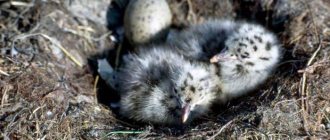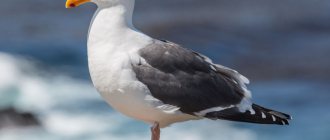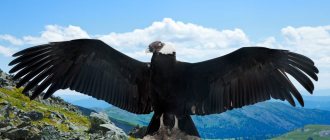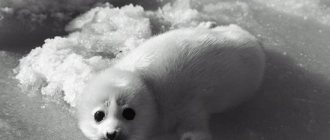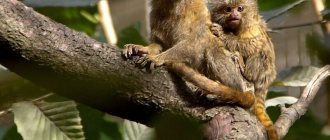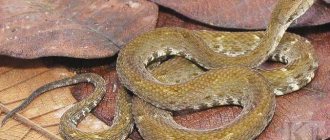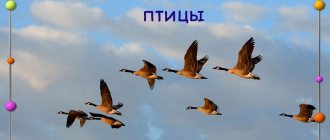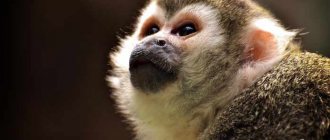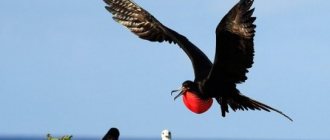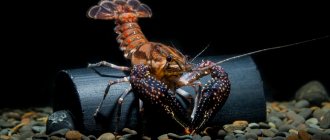The fauna of the Earth is extremely diverse and never ceases to amaze and amaze the imagination even in our age of total urbanization. Every year, up to a hundred species of different animals disappear irrevocably on the planet. Birds are no exception, and today there are more than 50 species of birds in the world that are on the verge of extinction. Recent research by ornithologists has revealed the rarest birds in the world, which are almost impossible to see. They have an extraordinary appearance and attractive beauty.
The rarest birds on Earth
| N | Bird | Area | Status in the Red Book |
| 1 | Great Indian kalao | W. India, Thailand, Sumatra | Close to vulnerable |
| 2 | Philippine eagle | Philippines | On the verge of extinction |
| 3 | Loddigesia | South Peru | An endangered species |
| 4 | Topacolo Stresemann | Brazil | On the verge of extinction |
| 5 | Honduran amazilia | Honduras | Endangered |
| 6 | Kakapo | South New Zealand | On the verge of extinction |
| 7 | Kagu | New Caledonia | An endangered species |
| 8 | Newton's Shrike | Sao Tome Islands | On the verge of extinction |
| 9 | Bermuda typhoon | Castle Harbor Islands | An endangered species |
| 10 | Brown momot | South America | Least of concern |
| 11 | Scaly bird of paradise | Guinea | Least of concern |
| 12 | Curly-haired arasari | Amazon Basin | Least of concern |
Red-footed Asian ibis
The rarest bird in the world is the Red-footed (Asian) ibis. In nature, this amazing creature lives in the Far East of Russia, China and Japan. According to preliminary data, at the beginning of the last century the number of these birds was 100.
Now it is difficult to accurately calculate; Ibis prefers to settle on very tall trees and in mountain gorges. The appearance of the bird is beautiful: thick snow-white plumage covers the body; the beak, head and legs are painted bright red; the top of the head is decorated with a magnificent crest. The reason for the extinction of the species is considered to be hunting and massive deforestation.
Red-footed (Asian) ibis
Screamer eagle
The king of the air spaces of the island of Madagascar is the Screaming Eagle. Over the last century, the numbers of this species have decreased catastrophically, to several dozen pairs.
This bird from the hawk family prefers freedom in all its forms. The current habitat is a small island on the western side of the island. The body length reaches 58-65 cm, the wingspan is 1.5-2 m.
The body and wings are covered in black, brown or dark gray. A distinctive feature of eagles is their snow-white head, neck and tail. The eagle loves highlands and prefers to live near bodies of water.
In the photo there is a screaming eagle bird
Newton's Shrike
A representative of the shrike family is endemic to the island. Sao Tome, located near the western coast of the African continent. The bird was named after the European scientist F. Newton, who described it at the end of the 19th century. Shrikes are medium-sized, about 20 cm in length, similar in appearance to flycatchers: shiny black back feathers and a pale yellow belly.
They live in the thick of the lower tier of the humid tropics of rocky foothills, at an altitude of up to 800 m. It is assumed that the island was inhabited by birds about 1.5 million years ago, and they gradually adapted to landscape changes. These shrikes are the only ones living in the dense wilds of untouched forests. Other species prefer open spaces with low vegetation. The bird has still been studied very little and most information about its life requires confirmation of authenticity.
Spatelteil
Spatelteil is a miniature bird, reaching a length of only 10-15 cm. It can rightfully be classified as one of the rarest birds . The uniqueness of this specimen lies in its appearance.
In addition to the fact that the body is covered with bright plumage, the tail consists of only four feathers. Two of them are short, and the other two are elongated and have a bright blue tassel at the end.
Due to the massive deforestation of the tropical forest, the bird is forced to migrate and can only be seen in remote corners of Peru, for example in Rio Utcumbuba.
In the photo there is a rare bird Spatelteil
Security measures
People are trying in every possible way to preserve the rarest individuals listed in the Red Book around the world. First of all, control over poachers has been tightened. It is prohibited to shoot or catch birds during the mating season. Some species, for example, the Japanese ibis, are prohibited from being caught in principle.
- Experts are trying to breed rare representatives in captivity around the world, in specialized reserves. Representatives of endangered species are housed in pairs, providing all conditions for living and reproduction.
- Some countries have banned the cutting down of forests where rare and endangered bird species most often nest.
- Unfortunately, no protective measures will help people deal with weather conditions. Every year the climate is changing, not for the better, birds are dying out due to the lack of usual weather conditions.
ground cuckoo
The humid forests of southern Sumatra are home to a very rare representative of the cuckoo family, the Earthling. The bird is too shy, so it is problematic to describe it and capture it in a photo.
It was first discovered two hundred years ago. It took a long time to study the behavior and cry of the bird. Only the lenses and microphones of modern cameras were able to capture the Earth Cuckoo. The body is covered with thick black or brown feathers. The comb and tail are dark green. Ornithologists counted only 25 individuals.
In the photo there is a ground cuckoo
Bengal Bustard
In the steppe and semi-desert expanses of Indochina, it is very rare to see the Bengal Bustard. The main reasons for the decline in numbers are incessant hunting and large amounts of pesticides.
Previously, the bird inhabited vast regions of Nepal, India and Cambodia. The bustard runs well, although it can also fly. The color of the body can be light gray or dark brown. The long neck is white or black. There are now approximately 500 individuals.
Pictured is a Bengal bustard
Philippine monkey eater
The large eagle is the official symbol of the Philippines. In fact, it feeds on small monkeys, although it prefers mammals. Monkey eaters reproduce very slowly. The reason for the decline in their numbers is hunting, capturing young individuals for zoos, and death due to deer traps set by farmers. Since the last century, birds have been captured and hatched artificially. During this time, conservation programs released several individuals into the wild, but all of them died due to human actions.
Now the population of Philippine monkey eaters is no more than 500 individuals.
Honduran Emerald
The Honduran Emerald is the rarest bird in the world , it belongs to the hummingbird subspecies. It has miniature sizes, approximately 9-10 cm. The small compact body is covered with thick feathers, the color on the head and neck resembles emerald tints.
The elongated beak makes up a third of the size of the bird. The habitat is dense bushes and forests. The bird prefers a dry climate and avoids wet jungles.
Bird Honduran Emerald
Kakapo
Kakapo is a relative of parrots, but this bird is so strange and attractive that once you get to know it better, you want to watch it forever. Why? The bird is only nocturnal and does not know at all what it is to fly.
Natural habitat: New Zealand. The parrot gets along well with reptiles and snakes. It has bright green plumage, short legs, a large beak and a gray tail. It prefers to live in burrows; most specimens are perfectly preserved in nature reserves; in the wild, their number reaches 120 individuals.
Pictured is a kakapo bird
California condor (Gymnogyps californianus)
The large bird, with a wingspan of up to three meters and a weight of 14 kilograms, was once widespread in the western part of what is now the United States. The condor is one of the longest-living birds, its lifespan can reach 60 years. The disastrous thing for the California condor was that it was considered a prestigious hunting trophy. Other factors also had an impact: the presence of only one chick in the brood, late onset of puberty, lead poisoning (from bullets in the corpses of animals that the condor feeds on), DDT poisoning, power lines. In addition, among farmers who saw condors on the corpses of domestic animals, a belief spread that these birds killed small lambs and calves. It is so ingrained in the population of Arizona that when a program to restore the condor population began, it caused protests from local ranchers.
By 1981, there were only 21 condors. All birds were caught and bred in captivity. Then they gradually began to be released back into the wild. This process was long due to the slow rate of condor reproduction. In addition, the birds had to be trained to avoid power lines and people. The first birth of a condor chick in the wild was noted in 2003. There are currently just over 400 birds, of which about half are kept in captivity. As a measure to protect condors, the state of California passed a special law (Ridley-Tree Condor Preservation Act), which obligated hunters in the condor habitat not to use lead bullets, which are poisonous to these birds.
Palila
Palila is a fabulous bird from the finch family. It is also called the “saffron finch flower girl”, an inhabitant of the paradise Hawaiian islands. The beak is small in size, the body length reaches 18-19 cm, the head and neck are golden in color, the abdomen and wings are white or gray.
The bird prefers dry forests and highlands, feeding on seeds and buds of Sophora aureus. It was on the verge of extinction due to the massive cutting down of an endemic tree.
In the photo, a rare bird was scorching
Brazilian Merganser
This rare bird was discovered in Brazil. The Brazilian merganser can be described as follows: it reaches a length of 49-56 cm, with a long, slender comb like a duck’s, dark in color, dark gray upper part with a black hood and a white belly.
This bird lives, as mentioned earlier, in Brazil. Prefers fast rivers with clear water and other shallow waters.
Philippine eagle
A large representative of the hawk family is the Philippine eagle, one of the rarest and largest birds on the planet. The bird is considered a natural treasure of the country, and any negative impact on the bird is punishable by law.
Habitat: only the tropics of the Philippines. The bird is popularly called a “harpy”; the population in nature numbers only 300-400 individuals. The reason for the decline in numbers is the human factor and the destruction of natural living space.
The body length is 80-100 cm, the wingspan is more than two meters. The back and wings are dark brown, the belly is white, a huge beak, and strong clawed paws. Eagles love to hunt monkeys in pairs.
Philippine Eagle
Philippine eagle or harpy monkey-eater
The predator from the hawk family belongs to the rarest, largest and strongest birds on the planet. Its habitat is the forest tropics of the Philippine archipelago. Being endemic to the state, the eagle is depicted on the country's coat of arms. The bird is impressive in size - more than a meter in length with a weight of 6 kg. Its wings reach a 2-meter span.
The monkey-eating harpy actually preys on local macaques, but other mammals and birds are part of its daily diet. The eagle nests at a height of 40 m, choosing the crowns of trees. Moreover, it lays a single egg once every 2 years. Each eagle pair needs a vast territory for nesting, and deforestation of 90% of forests drives them into an “evolutionary dead end.” Philippine law harshly punishes the murder of a state symbol with 12 years in prison and a large fine.
Owl Nightjar
The Owl Nightjar is a very mysterious and rare bird. Found only on the island of New Caledonia. Ornithologists were lucky enough to see and describe only two individuals. Birds are nocturnal, nesting in deep hollows or remote caves.
Nightjars are solitary creatures; how they behave throughout the day has not been studied. The head is round, the body is 20-30 cm long, the beak is small, surrounded by long bristles. It seems that the bird has no mouth; it is popularly called the “owl frogmouth.”
Bird Owl Nightjar
What birds are rare in the vastness of our country? It would seem that the state has tightened the program for the conservation of flora and fauna, there is strict control over poachers, nature reserves are being created... And yet, there are many birds in the country that are on the verge of extinction.
Within the Russian Federation, only the Far Eastern region remains, where birds live in a pristine natural environment. The southern Amur region is precisely the corner where glaciers simply did not reach.
Ornithological scientists unanimously claim that only here the descendants of prehistoric birds have been preserved. This is evidenced by the structural features of their body and the characteristics of extinct species. I would like to list the rarest birds found in Russia .
Rare birds. Description and features of rare birds
More than 10.5 thousand species of birds are known in the world. This number is catastrophically decreasing every year, and most birds have already disappeared. The ancient inhabitants are called “relics”; ornithologists simply did not have time to study and describe many individuals.
At the moment, defenders of flora and fauna have taken up the task of preserving rare endangered birds . Relics are under state protection and scrupulous quantitative control. Strict localization of the habitat of these birds is noted.
There are several reasons for the disappearance of ancient birds:
1. Natural. Many specimens simply cannot survive in warmer climates.
2. Urbanization. There are few places of natural origin left; megacities have replaced forests and steppes.
3. Bad environment. Emissions into the atmosphere and the world's oceans provoke a large number of dangerous diseases.
4. Poachers. They catch rare birds and sell them for huge sums of money.
I would like to list the names of rare birds ; their number on the planet ranges from several tens to several thousand. Statistics show that only protected areas are capable of preserving endangered birds.
* The rarest bird in the world is the Red-footed (Asian) ibis. In nature, this amazing creature lives in the Far East of Russia, China and Japan. According to preliminary data, at the beginning of the last century the number of these birds was 100.
Now it is difficult to accurately calculate; Ibis prefers to settle on very tall trees and in mountain gorges. The appearance of the bird is beautiful: thick snow-white plumage covers the body; the beak, head and legs are painted bright red; the top of the head is decorated with a magnificent crest. The reason for the extinction of the species is considered to be hunting and massive deforestation.
Red-footed (Asian) ibis
*The king of the air spaces of the island of Madagascar is the Screaming Eagle. Over the last century, the numbers of this species have decreased catastrophically, to several dozen pairs.
This bird from the hawk family prefers freedom in all its forms. The current habitat is a small island on the western side of the island. The body length reaches 58-65 cm, the wingspan is 1.5-2 m.
The body and wings are covered in black, brown or dark gray. A distinctive feature of eagles is their snow-white head, neck and tail. The eagle loves highlands and prefers to live near bodies of water.
In the photo there is a screaming eagle bird
*Spatelteil is a miniature bird, reaching a length of only 10-15 cm. It can rightfully be classified as one of the rarest birds . The uniqueness of this specimen lies in its appearance.
In addition to the fact that the body is covered with bright plumage, the tail consists of only four feathers. Two of them are short, and the other two are elongated and have a bright blue tassel at the end.
Due to the massive deforestation of the tropical forest, the bird is forced to migrate and can only be seen in remote corners of Peru, for example in Rio Utcumbuba.
In the photo there is a rare bird Spatelteil
* The humid forests of southern Sumatra are home to a very rare representative of the cuckoo family – the Earthling. The bird is too shy, so it is problematic to describe it and capture it in a photo.
It was first discovered two hundred years ago. It took a long time to study the behavior and cry of the bird. Only the lenses and microphones of modern cameras were able to capture the Earth Cuckoo.
The body is covered with thick black or brown feathers. The comb and tail are dark green. Ornithologists counted only 25 individuals.
In the photo there is a ground cuckoo
*In the steppe and semi-desert expanses of Indochina, it is very rare to see the Bengal Bustard. The main reasons for the decline in numbers are incessant hunting and large amounts of pesticides.
Previously, the bird inhabited vast regions of Nepal, India and Cambodia. The bustard runs well, although it can also fly. The color of the body can be light gray or dark brown. The long neck is white or black. There are now approximately 500 individuals.
Pictured is a Bengal bustard
* The Honduran Emerald is the rarest bird in the world , it belongs to the hummingbird subspecies. It has miniature sizes, approximately 9-10 cm. The small compact body is covered with thick feathers, the color on the head and neck resembles emerald tints.
The elongated beak makes up a third of the size of the bird. The habitat is dense bushes and forests. The bird prefers a dry climate and avoids wet jungles.
Bird Honduran Emerald
* Kakapo is a relative of parrots, but this bird is so strange and attractive that, once you get to know it better, you want to watch it forever. Why? The bird is only nocturnal and does not know at all what it is to fly.
Natural habitat: New Zealand. The parrot gets along well with reptiles and snakes. It has bright green plumage, short legs, a large beak and a gray tail. It prefers to live in burrows; most specimens are perfectly preserved in nature reserves; in the wild, their number reaches 120 individuals.
Pictured is a kakapo bird
* Palila is a fabulous bird from the finch family. It is also called the “saffron finch flower girl”, an inhabitant of the paradise Hawaiian islands. The beak is small in size, the body length reaches 18-19 cm, the head and neck are golden in color, the abdomen and wings are white or gray.
The bird prefers dry forests and highlands, feeding on seeds and buds of Sophora aureus. It was on the verge of extinction due to the massive cutting down of an endemic tree.
In the photo, a rare bird was scorching
* A large representative of the hawk family is the Philippine Eagle, one of the rarest and largest birds on the planet. The bird is considered a natural treasure of the country, and any negative impact on the bird is punishable by law.
Habitat: only the tropics of the Philippines. The bird is popularly called a “harpy”; the population in nature numbers only 300-400 individuals. The reason for the decline in numbers is the human factor and the destruction of natural living space.
The body length is 80-100 cm, the wingspan is more than two meters. The back and wings are dark brown, the belly is white, a huge beak, and strong clawed paws. Eagles love to hunt monkeys in pairs.
Philippine Eagle
* Owl Nightjar is a very mysterious and rare bird. Found only on the island of New Caledonia. Ornithologists were lucky enough to see and describe only two individuals.
Birds are nocturnal, nesting in deep hollows or remote caves. Nightjars are solitary creatures; how they behave throughout the day has not been studied. The head is round, the body is 20-30 cm long, the beak is small, surrounded by long bristles. It seems that the bird has no mouth; it is popularly called the “owl frogmouth.”
Bird Owl Nightjar
What birds are rare in the vastness of our country? It would seem that the state has tightened the program for the conservation of flora and fauna, there is strict control over poachers, nature reserves are being created... And yet, there are many birds in the country that are on the verge of extinction.
Within the Russian Federation, only the Far Eastern region remains, where birds live in a pristine natural environment. The southern Amur region is precisely the corner where glaciers simply did not reach.
Ornithological scientists unanimously claim that only here the descendants of prehistoric birds have been preserved. This is evidenced by the structural features of their body and the characteristics of extinct species. I would like to list the rarest birds found in Russia .
* White-eye is a miniature bird with bright, thick plumage. The upper part of the body and wings are colored light green, the abdomen and crop are lemon-colored. The beak is small, the distinctive feature is that the eye is surrounded by a white border.
It lives in forest belts, groves and on the outskirts of dense thickets. According to scientific data, the white-eye is a tropical bird, but for some reason it has chosen the forests of the Amur. It nests high in thickets and lives in pairs or flocks, sometimes alone.
In the photo there is a white-eyed bird
* The Paradise Flycatcher is a tropical bird found primarily in Korea, China, India and Afghanistan. For unknown reasons, the bird population has moved to the coastal regions of Russia and Central Asia.
The elongated body is covered on top with orange plumage, the head is painted bright blue. The flycatcher is a migratory bird; it has chosen our region because of bird cherry shoots. It feasts on the buds and seeds of this plant. The body is decorated with a long stepped tail, and a thick crest opens on the head during flight.
Bird of paradise flycatcher
* The pink gull is a rare species of bird due to the fact that the bird's habitat is very limited. A distinctive feature of the seagull is its unusual pink tint of plumage, which is actually rare.
The area of natural origin is considered to be the Kolyma, the area between the Yana, Indigirka and Alazeya rivers. Sometimes the pink gull wanders to the waters of America, which happens very rarely.
It nests in the tundra zone, where there are many lakes, and does not like to be close to humans. Now the bird is under strict protection and scrupulous counting of numbers.
Pink gull bird
* The most beautiful representative of the ducks is the Mandarin duck, she comes from Japan. Habitat: dense forests of the Far East (Amur and Sakhalin regions). A small wood duck with bright multi-colored plumage.
Inhabits the forests of mountain rivers, swims and dives well, feeds on aquatic plants and acorns. The mandarin duck is a wonderful flyer, however, it can often be seen sitting on the branches. Listed in the Red Book of Russia. The main reason for the decline in numbers is hunting and forest dogs that harm the bird’s nests.
In the photo there is a mandarin duck
* Scaly Merganser is one of the most ancient and relict inhabitants of our planet. The ancestor of this duck is considered to be “Ichthyornis”; the obvious similarity between them is the unusual arrangement of teeth in the beak, reminiscent of a hacksaw.
The body structure is compact, streamlined, the body is of medium size. The bird flies quickly, dives and swims well. The main diet is fry and small fish. The merganser settles along the banks of rivers and lakes.
It nests in very inaccessible places; the nest is difficult to see and find. The upper part of the body is colored chocolate, and the feathers have light spots that create the effect of scales.
Pictured is Scaly Merganser
* The rock thrush is a rare and shy bird with a very beautiful song. It can be heard more often than seen. Natural habitat is mountain peaks and cedar forests.
It nests very high, so it is impossible to see the nest and clutch. There are cases when the blackbird laid the clutch right on the ground among the stones. The bird is small in size and has an unusual plumage color.
The blackbird adapts to its environment and is colored blue or silver-gray. The abdomen has a brick or red tint. The rock thrush is a magnificent singer; its trills can be heard over a radius of many hundreds of meters. The bird also likes to copy other sounds that are interesting to him: hissing, sneezing, sirens...
The photo shows the bird Rock Thrush
* The Okhotsk snail is a rare species of waders that lives mainly in the Far East. However, many ornithological expeditions found these birds on the shores of the Sea of Okhotsk, Kamchatka and Sakhalin.
The length of the body is 30-32 cm. The head is small in size with a long beak slightly curved upward. The plumage is gray or brown. It feeds on small mollusks, fish and insects. At the moment, this species of waders is protected and is considered a very rare bird , the number of individuals is approximately 1000.
Okhotsk snail bird
* The blue magpie is a rare representative of the corvid family, an inhabitant of East Asia. Valued by ornithologists because of its unusual color - the main part of the body is covered with a soft blue color.
The head is painted black, a strict line is drawn along the beak. The length of the body is 35-40 cm, the abdomen becomes beige or light brown.
An interesting fact is that the magpies’ habitats are separated by a huge distance. One part is located in Europe (Iberian Peninsula), the other in Transbaikalia, the Baikal region, China, Korea, Japan and Mongolia.
Blue Magpie
* The black crane is the rarest representative of its family. It nests mainly in Russia. The crane is listed in the Red Book, has still been little studied, and now there are approximately 9-9.5 thousand individuals.
This bird is small in size, reaching only 100 cm in height. The plumage is dark gray or blue, the neck is long and white. The beak has a greenish tint, there is a bright red spot on the crown, there are no feathers in this area, only short bristly processes cover the skin. Habitat: hard-to-reach marshy places and swamps; it feeds on food of plant and animal origin.
Pictured is a Black Crane
* Siberian grouse is a little-studied and rare bird from the grouse family. Her photo is in a place of honor among rare endangered birds . The ancient inhabitant of the taiga has a friendly character and is not at all afraid of humans.
It is for this reason that it becomes a trophy for many hunters. The bird is small in size and has a brown, dark gray or black color. There may be white spots on the sides and back. Habitats: Amur Territory and Sakhalin. It feeds on pine needles, insects, berries and seeds. Rarely flies, moves mainly on the ground.
In the photo there is a Siberian grouse bird
I really want rare bird species to please the eye for a long time. It all depends only on the person, because it is possible to organize more protected areas where birds will feel comfortable and not migrate away from people.
White-eye
The white-eye is a miniature bird with bright, dense plumage. The upper part of the body and wings are colored light green, the abdomen and crop are lemon-colored. The beak is small, the distinctive feature is that the eye is surrounded by a white border.
Inhabits forest belts, groves and on the outskirts of dense thickets. According to scientific data, the white-eye is a tropical bird, but for some reason it has chosen the forests of the Amur River. It nests high in thickets and lives in pairs or flocks, sometimes alone.
In the photo there is a white-eyed bird
Paradise Flycatcher
The Paradise Flycatcher is a tropical bird found primarily in Korea, China, India and Afghanistan. For unknown reasons, the bird population has moved to the coastal regions of Russia and Central Asia.
The elongated body is covered on top with orange plumage, the head is painted bright blue. The flycatcher is a migratory bird; it has chosen our region because of bird cherry shoots. It feasts on the buds and seeds of this plant. The body is decorated with a long stepped tail, and a thick crest opens on the head during flight.
Bird of paradise flycatcher
Pink seagull
The pink gull is a rare species of bird due to the fact that the bird's habitat is very limited. A distinctive feature of the seagull is its unusual pink tint of plumage, which is actually rare.
The area of natural origin is considered to be the Kolyma, the area between the Yana, Indigirka and Alazeya rivers. Sometimes the pink gull migrates to the waters of America, which happens very rarely. It nests in the tundra zone, where there are many lakes, and does not like to be close to humans. Now the bird is under strict protection and scrupulous counting of numbers.
Pink gull bird
Curly-haired arasari
Bizarrely beautiful creatures of the toucan family live in the territories of central and southern Brazil, in the Amazon and Madeira basins. Crested arasari are the largest and brightest representatives of toucans. With a body length of 45 cm, they weigh 200-300 g. A distinctive feature of the bird is the curls of black feathers on its head, as if smeared with wax gel.
The feather color of the curly-haired beauty includes almost the entire color palette with dark red, orange, green, yellow and blue flowers. The toucan's diet includes fruits and insects. However, he will gladly feast on a small bird or destroy someone else's nest. The curly exotic takes root well in captivity, is very sociable and inquisitive. Unfortunately, these birds are becoming extinct, their natural habitat is constantly shrinking due to human activity.
Mandarin duck
The most beautiful representative of the duck species is the mandarin duck, which comes from Japan. Habitat: dense forests of the Far East (Amur and Sakhalin regions). A small wood duck with bright multi-colored plumage.
Inhabits the forests of mountain rivers, swims and dives well, feeds on aquatic plants and acorns. The mandarin duck is a wonderful flyer, however, it can often be seen sitting on the branches. Listed in the Red Book of Russia. The main reason for the decline in numbers is hunting and forest dogs that harm the bird’s nests.
In the photo there is a mandarin duck
Forest Owl (Heteroglaux blewitti)
A little-studied bird from Central India. It was described by F. Blewitt in 1872. After 1884, it did not catch the eye of ornithologists and was considered extinct. However, more than a hundred years later, in 1997, an expedition led by the famous ornithologist Pamela Rasmussen from the Smithsonian Institution was able to rediscover this bird.
Interestingly, lengthy searches for the Indian Forest Owl were unsuccessful due to fraud. Ornithologists sent expeditions to those areas where, according to the labels on the carcasses stored in the British Museum, these birds were killed. However, as it turned out later, these birds were once stolen from the museum by Richard Meinertzhagen, a British intelligence officer, traveler, naturalist and adventurer. Meinertzhagen then again provided the birds to the British Museum, as if he had obtained them himself. And he pointed out the false places where these birds were supposedly caught. The owl lives in dense forests, feeds on lizards, rodents and invertebrates; many details of the life of the Indian forest owl still remain unknown. The number is estimated at 250 individuals.
Scaly Merganser
The scaly merganser is one of the most ancient and relict inhabitants of our planet. The ancestor of this duck is considered to be “Ichthyornis”; the obvious similarity between them is the unusual arrangement of teeth in the beak, reminiscent of a hacksaw.
The body structure is compact, streamlined, the body is of medium size. The bird flies quickly, dives and swims well. The main diet is fry and small fish. The merganser settles along the banks of rivers and lakes. It nests in very inaccessible places; the nest is difficult to see and find. The upper part of the body is colored chocolate, and the feathers have light spots that create the effect of scales.
Pictured is Scaly Merganser
Rock Thrush
The rock thrush is a rare and shy bird with a very beautiful song. It can be heard more often than seen. Natural habitat is mountain peaks and cedar forests. It nests very high, so it is impossible to see the nest and clutch. There are cases when the thrush placed the clutch directly on the ground among the stones. The bird is small in size and has an unusual plumage color.
The blackbird adapts to its environment and is colored blue or silver-gray. The abdomen has a brick or red tint. The rock thrush is a magnificent singer; its trills can be heard over a radius of many hundreds of meters. The bird also likes to copy other sounds that are interesting to him: hissing, sneezing, sirens...
The photo shows the bird Rock Thrush
Demoiselle crane
These rare birds are the smallest species of cranes. Birds live in six regions of the world, including Russia. Here they mainly settle on the Black Sea coast. They live in open areas, which also distinguishes them from other types of cranes that inhabit swampy areas. Belladonnas form a pair for life, and if the pair does not produce offspring, it breaks up.
Demoiselle belladonnas make a nest right on the ground. To do this, they dig a hole and then strengthen it with twigs. After 29 days, the chicks hatch.
Okhotsk ulit
The Okhotsk snail is a rare species of waders that lives mainly in the Far East. However, many ornithological expeditions found these birds on the shores of the Sea of Okhotsk, Kamchatka and Sakhalin.
The length of the body is 30-32 cm. The head is small in size with a long beak slightly curved upward. The plumage is gray or brown. It feeds on small mollusks, fish and insects. At the moment, this species of waders is protected and is considered a very rare bird , the number of individuals is approximately 1000.
Okhotsk snail bird
Christmas frigate (Fregata andrewsi)
A large dark bird with long narrow wings and a forked tail. Like other frigates, it is clumsy on land and unable to swim, but is an extremely skilled flyer. It grabs prey from coastal beaches or from the surface of the water, and is capable of catching flying fish in the air. Justifying the English name of frigate birds Man of War birds or Pirate birds, it attacks gannets, terns, gulls, and cormorants returning from fishing, chases them and hits them with its beak. When the victim of the attack regurgitates the caught fish, the frigate deftly catches it in the air, preventing it from falling into the water. This bird lives on Christmas Island in the Indian Ocean.
The Christmas frigate bird is endangered because of an ant. In the first half of the 20th century, a species of ant, Anoplolepis gracilipes, was accidentally introduced to Christmas Island and was called the “crazy yellow ant.” It also hit a number of other islands in the Indian and Pacific oceans. These ants reproduce intensively and are capable of eating almost any invertebrate. On Christmas Island in particular, they destroyed up to 20 million native red earth crabs (Gecarcoidea natalis). The red land crab is important to the island's ecosystem; a sharp decline in their numbers leads to changes in the structure of forests. It is not yet completely clear whether the ants directly attack the chicks in the nests, but with their appearance, the number of Christmas frigatebirds, as well as a number of other species of Christmas Island birds, began to rapidly decline.
Blue Magpie
The blue magpie is a rare representative of the corvid family, native to East Asia. Valued by ornithologists because of its unusual color - the main part of the body is covered with a soft blue color. The head is painted black, a strict line is drawn along the beak. The length of the body is 35-40 cm, the abdomen becomes beige or light brown.
An interesting fact is that the magpies’ habitats are separated by a huge distance. One part is located in Europe (Iberian Peninsula), the other in Transbaikalia, the Baikal region, China, Korea, Japan and Mongolia.
Blue Magpie
black crane
The black crane is the rarest representative of its family. It nests mainly in Russia. The crane is listed in the Red Book, has still been little studied, and now there are approximately 9-9.5 thousand individuals.
This bird is small in size, reaching only 100 cm in height. The plumage is dark gray or blue, the neck is long and white. The beak has a greenish tint, there is a bright red spot on the crown, there are no feathers in this area, only short bristly processes cover the skin. Habitat: hard-to-reach marshy places and swamps; it feeds on food of plant and animal origin.
Pictured is a Black Crane
Momot brown or blue-browed
A rare representative of the bright, multi-colored momot family is a medium-sized bird with a luxurious tail - the blue-browed momot. It lives in tropical forests of Mexico and Argentina. The bird, no more than 30 cm in length, is distinguished by a very long, pointed tail and ultramarine brow ridges.
Momots live in pairs and build nests in long tunnels, which they dig in the sandstones of coastal cliffs near water bodies. Such a hole can be about 2 m in length. It is difficult to imagine the effort the bird makes during excavation work. Birds are hunters of large insects and small lizards; they also respect fruits and berries.
Dikusha
Siberian grouse is a little-studied and rare bird from the grouse family. Her photo is in a place of honor among rare endangered birds . The ancient inhabitant of the taiga has a friendly character and is not at all afraid of humans.
It is for this reason that it becomes a trophy for many hunters. The bird is small in size and has a brown, dark gray or black color. There may be white spots on the sides and back. Habitats: Amur Territory and Sakhalin. It feeds on pine needles, insects, berries and seeds. Rarely flies, moves mainly on the ground.
In the photo there is a Siberian grouse bird
I really want rare bird species to please the eye for a long time. It all depends only on the person, because it is possible to organize more protected areas where birds will feel comfortable and not migrate away from people.
